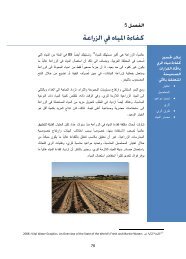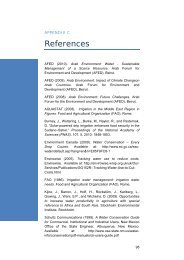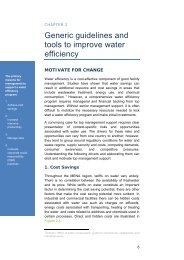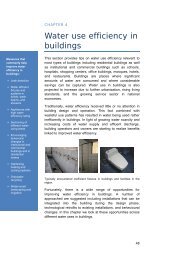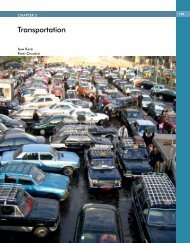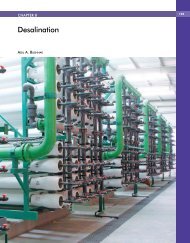Impact of Climate Change on Arab Countries - (IPCC) - Working ...
Impact of Climate Change on Arab Countries - (IPCC) - Working ...
Impact of Climate Change on Arab Countries - (IPCC) - Working ...
You also want an ePaper? Increase the reach of your titles
YUMPU automatically turns print PDFs into web optimized ePapers that Google loves.
18<br />
CHAPTER 2<br />
GHG EMISSIONS: MITIGATION EFFORTS IN THE ARAB COUNTRIES<br />
duced tax exempti<strong>on</strong>s <strong>on</strong> hybrid cars as an incentive<br />
to promote their use.<br />
These measures have had c<strong>on</strong>siderable effects <strong>on</strong><br />
reducing road c<strong>on</strong>gesti<strong>on</strong>, minimizing idling<br />
time, and, thus, reducing transport energy intensity.<br />
Furthermore, the government recognizes the<br />
need for a major upgrading <str<strong>on</strong>g>of</str<strong>on</strong>g> the road transport<br />
system. This was realized by establishing a Road<br />
Maintenance Fund through public-private partnerships<br />
and a system <str<strong>on</strong>g>of</str<strong>on</strong>g> road-user tolls.<br />
According to Jordan’s initial nati<strong>on</strong>al communicati<strong>on</strong>,<br />
“the rapid c<strong>on</strong>structi<strong>on</strong> <str<strong>on</strong>g>of</str<strong>on</strong>g> the Shidiya rail<br />
line is critical to the future <str<strong>on</strong>g>of</str<strong>on</strong>g> the railway sector.<br />
The government is c<strong>on</strong>sidering private financing<br />
as part <str<strong>on</strong>g>of</str<strong>on</strong>g> a c<strong>on</strong>cessi<strong>on</strong> agreement for private<br />
operati<strong>on</strong> and maintenance <str<strong>on</strong>g>of</str<strong>on</strong>g> rail services <strong>on</strong> this<br />
line.” Other planned priority investment projects<br />
in the transportati<strong>on</strong> sector include restructuring<br />
the public transport and development <str<strong>on</strong>g>of</str<strong>on</strong>g> a lightrail<br />
system. The government envisi<strong>on</strong>s that a substantial<br />
part <str<strong>on</strong>g>of</str<strong>on</strong>g> this planned development will be<br />
financed by domestic and foreign private sectors<br />
(Jordan, 1997).<br />
In Yemen, the first nati<strong>on</strong>al communicati<strong>on</strong><br />
reported that energy use in the transport sector<br />
could be reduced through a number <str<strong>on</strong>g>of</str<strong>on</strong>g> measures<br />
including fuel efficiency improvement, traffic<br />
management, improvement <str<strong>on</strong>g>of</str<strong>on</strong>g> freight transport,<br />
switching to less carb<strong>on</strong> fuels such as LPG, and<br />
public educati<strong>on</strong> (Yemen, 2001).<br />
The transport mitigati<strong>on</strong> strategies in Sudan<br />
identified several priority areas for government<br />
policy: development <str<strong>on</strong>g>of</str<strong>on</strong>g> transportati<strong>on</strong> infrastructure<br />
(roads, telecommunicati<strong>on</strong>s. etc.), encourage<br />
public transport and improve traffic flow, apply<br />
speed limits standards and fuel ec<strong>on</strong>omy standards,<br />
and encourage importati<strong>on</strong> <str<strong>on</strong>g>of</str<strong>on</strong>g> efficient<br />
vehicles (Sudan, 2003).<br />
The Industrial Sector<br />
The industrial sector is another major energy<br />
c<strong>on</strong>suming sector in most <str<strong>on</strong>g>of</str<strong>on</strong>g> the <strong>Arab</strong><br />
ec<strong>on</strong>omies. Most <strong>Arab</strong> countries, especially<br />
those which are highly endowed with hydrocarb<strong>on</strong><br />
resources (oil and gas) are mainly dependent<br />
<strong>on</strong> those resources to fuel their industries.<br />
Energy intensive industries such as oil refining,<br />
metal extracti<strong>on</strong>, chemicals and petrochemicals<br />
have been proliferating in the oil producing<br />
countries. This has been a global trend since the<br />
first world energy crises in 1973. In 2006, these<br />
industries c<strong>on</strong>tributed 49.5% to the <strong>Arab</strong> GDP<br />
(LAS, 2007). Due to the central importance <str<strong>on</strong>g>of</str<strong>on</strong>g><br />
these industries to the GDP, their low levels <str<strong>on</strong>g>of</str<strong>on</strong>g><br />
energy efficiency and the huge capacity <str<strong>on</strong>g>of</str<strong>on</strong>g> fossil<br />
based desalinati<strong>on</strong> plants in the GCC regi<strong>on</strong>,<br />
the energy and carb<strong>on</strong> intensities <str<strong>on</strong>g>of</str<strong>on</strong>g> the GCC<br />
countries are ranked very high by internati<strong>on</strong>al<br />
standards. For instance, in 2005, the energy<br />
intensity <str<strong>on</strong>g>of</str<strong>on</strong>g> Bahrain (0.77 toe/ $1000) was<br />
more than double the world average (0.32 toe/<br />
$1000) and about seven times the Japanese<br />
intensity (0.11 toe/ $1000).<br />
GHG emissi<strong>on</strong>s from industry include those<br />
resulting from burning fossil fuels, indirect emissi<strong>on</strong>s<br />
resulting from the use <str<strong>on</strong>g>of</str<strong>on</strong>g> electricity, and<br />
emissi<strong>on</strong>s related to certain industrial processes<br />
such as aluminium smelting, ir<strong>on</strong> and steel,<br />
cement, and the food industry.<br />
Several technologies have proved to be technically<br />
and ec<strong>on</strong>omically viable worldwide to improve<br />
industrial energy efficiency. These include industrial<br />
process c<strong>on</strong>trol, waste heat recovery,<br />
improvement <str<strong>on</strong>g>of</str<strong>on</strong>g> combusti<strong>on</strong> efficiency, energy<br />
management systems, combined heat and power<br />
(CHP), high efficiency lighting, high efficiency<br />
motors, and many others.<br />
Several <strong>Arab</strong> countries have adopted successful<br />
programmes for improving industrial energy efficiency<br />
including building nati<strong>on</strong>al capacities <strong>on</strong><br />
energy audits, energy accounting, and energy<br />
efficient technologies.<br />
Energy efficiency is an important strategy that<br />
has been adopted and promoted throughout the<br />
Egyptian ec<strong>on</strong>omy. Given the critical energy situati<strong>on</strong><br />
in Egypt, the high level <str<strong>on</strong>g>of</str<strong>on</strong>g> energy c<strong>on</strong>sumpti<strong>on</strong><br />
and the limited energy resources, it is<br />
imperative to c<strong>on</strong>serve energy in the major energy<br />
c<strong>on</strong>suming sectors, including the industrial<br />
sector which is the sec<strong>on</strong>d largest c<strong>on</strong>sumer <str<strong>on</strong>g>of</str<strong>on</strong>g><br />
electricity (36% <str<strong>on</strong>g>of</str<strong>on</strong>g> the total) (EEAA, 1999).<br />
Industrial energy efficiency measures included<br />
energy audits which showed an average potential<br />
saving <str<strong>on</strong>g>of</str<strong>on</strong>g> about 25% in Egypt mostly in the<br />
Egyptian Industries. Measures implemented<br />
include combusti<strong>on</strong> efficiency improvement,<br />
waste heat recovery, power factor improvement<br />
and use <str<strong>on</strong>g>of</str<strong>on</strong>g> efficient lighting systems.



